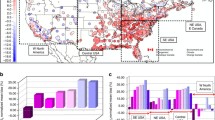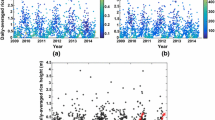Abstract
The capture of wind-driven cloud by vegetation provides a pathway for pollutant deposition that has only recently been identified, and remains only poorly quantified. This paper reviews current knowledge of three aspects of the pathway: measurement and modelling the rates of deposition of cloud water to various Vegetation types; techniques for monitoring the concentrations of soluble and solid material in cloudwater; and potential mechanisms for injury to Vegetation by the deposited material.
Although there have been many measurements of amount of fog drip below trees, there are very few where there is sufficient detail of the environmental conditions and plant structure to allow generalizations to be drawn. Analysis of existing measurements Supports the view that fog-water fluxes are essentially limited only by rates of turbulent transfer and so can be modelled realistically from a knowledge of momentum transfer. This can be shown to imply that fog-water fluxes are typically 1 mg.m−2.s−1 (4 μm.h−1) over Short grass and 10 mg.m−2.s−1 (40 μm.h−1) over forests. Analysis of drag forces on leaves and shoots can be used to show that isolated trees and shrubs capture fog water at rates of up to 100 mg.m−2.s−1, consistent with the few useful observations.
These analyses suggest that there is substantial spatial variation in fog-water deposition, for example at the upwind edges of forests, and on dominant trees in canopies. There will also be large vertical variation in a dense canopy in the amount of water deposited per unit foliage density — current knowledge of in-canopy wind profiles can be used to estimate this. Chemical concentrations in cloud water can be much larger than in rain. Apart from data at Whiteface Mountain, there do not appear to be long series of records to establish the “climatology” of cloud-water chemistry, i.e., its dependence on synoptic meteorology and the seasonal variability at sites. The design of collectors probably leads to biases, because of differing variations of collection efficiencies with drop size. In Britain, cloud water with large concentrations of acidic substances often contains substantial amounts of solid particles, and so vegetation may have much larger inputs of particulate material in this occult deposition than we have previously estimated when considering only dry deposition.
The low pH of cloud water may, by itself, be sufficient to damage foliage, by eroding cuticular waxes and, for example, directly injuring epidermal cells, or allowing increased leaching, or altering gas or water vapour exchange. Evaporation from the water film on leaf surfaces, proceeding simultaneously with evaporation, may lead to a further concentration of solution on the surface. Evaporation from forests would be very sensitive to small alterations in humidity (in the range 97–100% rh). For extensive forest canopies, the concentration ratio (surface liquid/cloud drop) may exceed 10, leading to surface pH below 3. The spatial variation of the concentration phenomenon within canopies and on isolated trees is likely to be large, and could help to explain the positioning of observed visible injury.
Large inputs of sulphur and nitrogen to upland forests by occult deposition may also increase the probability of frost injury to trees, both directly by altering membrane strength and indirectly through changes in rates of cold hardening.
Access this chapter
Tax calculation will be finalised at checkout
Purchases are for personal use only
Preview
Unable to display preview. Download preview PDF.
Similar content being viewed by others
References
Appel BR, Wall SM, Kothny EL, Tokiwa Y, Haik M (1980) Simul taneous nitric acid, particulate nitrate and acidity measurements in ambient air. Atmos Environ 14: 549–554
Ashmore M, Bell N, Rutter K (1985) The role of ozone in forest damage in West Germany. Ambio 14: 81–87
Baker CK, ünsworth MH, Greenwood P (1982) Leaf injury on wheat plants exposed in the field in winter to SO2. Nature 299:149–151
Baumgartner A (1952) Nebel und Nebelniederschlag als Standortfaktoren am Grossen Falkenstein (Bayerischer Wald). Forstw Cbl 77: 257–272
Byers HR (1953) Coast redwoods and fog drip. Ecology 34:192–193
Cannon WA (1901) Relation of redwoods and fog. Torreya 1:137–139
Carruthers DJ, Choularton TW (1984) Acid deposition in rain over hills. Atmos Environ 18: 1905–1908
Chamberlain AC (1975) The movement of particles in plant communities. In: Monteith JL (ed) Vegetation and the atmosphere, Vol 1. Academic Press, Lond, pp 155–203
Davidson AW, Bailey IF (1982) SO2 pollution reduces the freezing resistance of ryegrass. Nature 297: 400–401
Daum PH, Schwartz SE, Newman L (1984) Acidic and related constituents in liquid water stratiform clouds. J Geophys Res 89: 1447–1458
Dollard GJ, Unsworth MH (1983) Field measurements of turbulent fluxes of wind-driven fog drops to a grass surface. Atmos Environ 17: 775–780
Dollard GJ, Unsworth MH, Harvey MJ (1983) Pollutant transfer in upland regions by occult precipitation. Nature 302: 241–242
Ekern PC (1964) Direct interception of cloudwater on Lanaihale, Hawaii. Proc Soil Sei Soc Am 28: 419–421
Falconer RE, Falconer PD (1980) Determination of cloud water acidity at a mountain observatory in the Adirondack Mountains of New York State. J Geophys Res 85: 7465–7470
Fraser AI (1962) Wind tunnel studies of the forces acting on the crowns of small trees. Report on Forest Research, HMSO, London, pp 178–183
Friedland AJ, Gregory RA, Karenlamp L, Johnson AH (1984) Winter damage to foliage as a factor in red spruce decline. Can J For Res 14: 963–965
Garland JA, Branson JR, Cox LC (1973) A study of the contribution of pollution to visibility in a radiation fog. Atmos Environ 7: 1079–1092
Gervat GP (1985) Clouds at ground level: samples from the southern Pennines. Central Electricity Research Laboratories Report No. TDRD/L/2700/N84
Grunow J (1955) Die Niederschlag in Bergwald. Forstwiss Zentbl 74: 21–36
Hori T (1953) Studies on fogs. Tanne Trading Co Ltd, Sapporo
Houghton HJ (1955) On the chemical composition of fog and cloudwater. J Meteorology 12: 355–357
Jacobson JS (1980) The influence of rainfall composition on the yield and quality of agricultural crops. In: Drablos D, Tollan A (eds) Ecological impact of acid precipitation, SNSF, As-NLH, Norway
Johnson AH (this volume) Deterioration of red spruce in the Northern Appalachian Mountains.
Johnson AH, Siccama TG (1983) Acid deposition and forest decline. Environ Sei and Tech 17: 294–305
Johnson AH, Siccama TG (1984) Decline of red spruce in the northern Appalachians: assessing the possible role of acid deposition. TAPPI: 68–72
Keller TH (1981) Folgen einer winterlichen SO2 - Belastung fur die Fichte. Gartenbauwissenschaft 46: S170–178
Kerfoot O (1968) Mist precipitation on Vegetation. Forestry Abstracts 29: 8–20
Landsberg JJ, Jarvis PG (1973) A numerical investigation of the momentum balance of a spruce forest. J Appl Ecol 10: 645–655
Lazrus AL, Haagenson PL, Kok GL, Huebert BJ, Kreitzberg CW, Liken GE, Mohnen VA, Wilson WE, Winchester JW (1983) Acidity in air and water in a case of warm frontal precipitation. Atmos Environ 17: 581–591
Lovett GM (1984) Rates and mechanisms of cloud water deposition to subalpine fir forest. Atmos Environ 18: 361–371
Lovett GM, Reiners WA, Olson RK (1982) Cloud droplet deposition in subalpine baisam fir forests: hydrological and chemical inputs. Science 218: 1303–1304
Marloth R (1907) Results of further experiments on Table Mountain. Trans S Afr Phil Soc Cape Town 16: 97–105
Matzner E, Ulrich B (this volume) Results of studies on forest decline in northwest Germany.
Monteith JL (1975) (ed) Vegetation and the atmosphere, Vol 2, Academic Press, London, p 439
Mrose H (1966) Measurements of pH, and chemical analyses of rain-, snow-, and fog-water. Tellus 18: 266–270
Nagel JF (1956) Fog precipitation on Table Mountain. Quart J R Met Soc 82: 452–460
Nihlgard B (1985) The ammonium hypothesis - an additional explanation to the forest dieback in Europe. Ambio 14: 2–8
Oberlander GT (1956) Summer fog precipitation of the San Francisco peninsula. Ecology 37: 851–852
Okita T (1968) Concentration of sulfate and other inorganic materials in fog and cloud water and in aerosol. J Met Soc Japan 46: 120–127
Penman HL (1963) Vegetation and hydrology. Commonwealth Agricultural Bureaux, London
Prinz B, Krause GHM, Jung K-D (this volume) Responses of German forests in recent years: cause for concern elsewhere?
Rubner K (1935) Nebelniederschlag in Wald und seine Messung. Tharandter Forstl Jahrb 86: 330–342
Rutter AJ (1975) The hydrological cycle in Vegetation. In: Monteith JL (ed) Vegetation and the atmosphere, Vol 1. Academic Press, London, pp 111–154
Schutt P, Cowling EB (1985) Waldsterben - a general decline of forests in Central Europe: Symptoms, development, an possible causes of a beginning breakdown of forest ecosystems. Plant Disease 69: 548–558
Shuttleworth WJ (1977) The exchange of wind-driven fog and mist between vegetation and the atmosphere. Boundary-Layer Meteorology 12: 463–489
Smidt S (1983) Uber das Auftreten von Ozon und Stickstoffoxiden in Waldgebieten Osterreichs. European J For Path 13: S 133–141
Spaleny J (1981) Forst hardiness of Norway spruce needles in the polluted area of the Ore Mountains. Archiwum Ochrony Srodowiska, Polish Academy of Sciences 2–4: 145–153
Thorne PG, Lovett GM, Reiners WA (1982) Experimental determination of droplet impaction on canopy components of Balsam fir. J Appl Meteor 21: 1413–1416
Unsworth MH (1984) Evaporation from forests in cloud enhances the effects of acid deposition. Nature 312: 262–264
Waldman JD, Munger JW, Daniel JJ, Flagan RC, Morgan JJ, Hoffman MR (1982) Chemical composition of acid fog. Science 218:677–679
Walters PT, Moore MJ, Webb AH (1983) A Separator for obtaining samples of cloud water in aircraft. Atmos Environ 17:1083–1091
Yosida Z, Kuroiwa D (1953) Wind force on a conifer tree and the quantity of fog water thereby captured. In: Hori T (ed) Studies on fogs, Tanne Trading Co Ltd, Sapporo
Author information
Authors and Affiliations
Editor information
Editors and Affiliations
Rights and permissions
Copyright information
© 1987 Springer-Verlag Berlin Heidelberg
About this paper
Cite this paper
Unsworth, M.H., Crossley, A. (1987). Consequences of Cloud Water Deposition on Vegetation at High Elevation. In: Hutchinson, T.C., Meema, K.M. (eds) Effects of Atmospheric Pollutants on Forests, Wetlands and Agricultural Ecosystems. NATO ASI Series, vol 16. Springer, Berlin, Heidelberg. https://doi.org/10.1007/978-3-642-70874-9_12
Download citation
DOI: https://doi.org/10.1007/978-3-642-70874-9_12
Publisher Name: Springer, Berlin, Heidelberg
Print ISBN: 978-3-642-70876-3
Online ISBN: 978-3-642-70874-9
eBook Packages: Springer Book Archive




